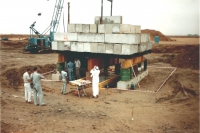Water Pipelines RWTS and MTTS, Saudi Arabia
Client: Joint Venture MAB/S-C (Mannesmann Anlagenbau AG, Düsseldorf / Al Rashid - HAK Consortium
Development Period: 1980 to 1987
In the context of the project "Riyadh Water Transmission System" (RWTS), drinking water is transferred from the Persian Gulf to the Saudi Arabian capital Riyadh. The double tube pipeline, each with a diameter of 150 cm, comprises a length of around 500 km and a transport capacity of 830.000 m³ per day. In the course of the pipes, six pumping stations are situated, while a difference in altitude of 700 m has to be overcome.
The water pipeline "Makkah Taif Transmission System" (MTTS) feeds demineralised sea water from the Red Sea to the towns of Mecca and Taif. This pipeline holds a length of altogether 150 km, seven pumping stations and a transport capacity of 180.000 m³ per day.
Dr. Peter Waibel, legal predecessor, founder and managing director of BGG Consult, has been commissioned for these projects with the planning, supervision and evaluation of the underground investigation works and with the preparation of foundation concepts. Based on numerous site visits before and during the subsoil investigation campaigns and on the results of soil mechanical laboratory tests (for reason of calibration partly run at the own laboratory in Rankweil, Austria), geotechnical expert's reports with regard to the foundation of the pumping stations and a pipeline bridge have been compiled. Furthermore, building pit dewatering concepts by means of vacuum wells have been dimensioned.
Subsequently, the construction was supervised in the field of geotechnics. For this, numerous site visits were necessary, e.g. for the approval of the foundation contact surfaces.
MTTS, Pumping Station 1, Subsoil Improvement:
The underground in the area of Pumping Station 1 of the project MTTS (situated immediately at the beginning of the line in Jeddah) consists in the upper metres of sand-clay mixture, varying in composition and also can contain salt layers ("Sabkha Deposits"). These materials consistently hold a loose compactness due to their genesis and usually have a high water content, because of the situation within the zone of fluctuation of the sea water level.
For this reason, an underground improvement was necessary. As most fitting method, gravel piles have been chosen and dimensioned. This method proved to be an economic and technically sufficient improvement variant. The bearing capacity of the gravel piles was verified by means of test loading (see photograph).
April 2001
